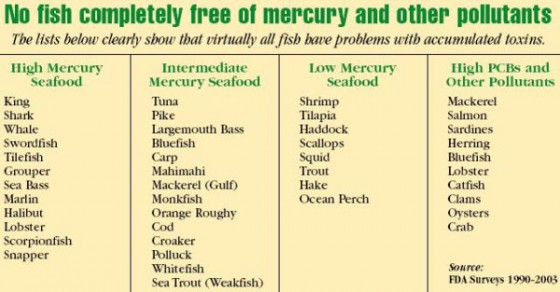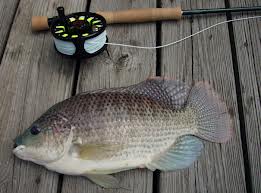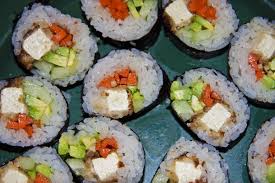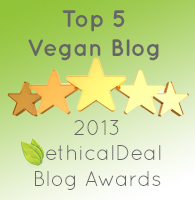THE EXPERTS WEIGH IN!
…plus Surprising Vegan Options at Sushi Restaurants!
Have you increased the amount of fish in your diet because you’ve read that it’s a healthy source of protein, minerals & vitamins? I made a pitstop at pescatarianism on my way from eating everything to eating only a plant-based diet. From my experience, the gradual elimination of meat from one’s diet results in the addition of more fish into your usual meal plan. Especially when we are inundated with articles and news about how healthy fish is, it seems natural to think that more is better. This fish-based diet seemed to be a great way to go for me until I did some investigating about the potential dangers in eating certain fish in particular and seafood, in general. Even small amounts of particular fish can be harmful. Further research showed me that I can get the nutrients that fish offer in plant-based sources.
According to an article titled, “12 Fish You Should Never Eat” by Emily Main, the nonprofit organization Food and Water Watch studied the many varieties of fish available, how they were harvested, how certain species are farmed, and levels of toxic contaminants like mercury or PCBs in the fish, as well as how heavily local fishermen relied upon fisheries for their economic survival. These are the 12 fish that they determined we should never eat:
1) Imported Catfish: 90% come from Vietnam where antibiotics that are banned in the US is widespread, 2 varieties aren’t technically considered catfish by the US gov’t and aren’t held to the same inspection rules.
2) Caviar: comes from beluga and wild-caught sturgeon, subject to overfishing and an increase in pollution in the water in which they live
3) Atlantic Cod: chronic mismanagement and low stock has put the species one step above endangered
4) American Eel (yellow or silver eel): commonly found in sushi, highly contaminated with PCB’s & mercury, fisheries are suffering from pollution and overharvesting
5) Imported Shrimp: the dirtiest fish with contaminants like antibiotics, residues of chemical used to clean pens, mouse and rat hair, pieces of insects, E. coli, 90% of shrimp sold in the US is imported, less than 2% of all Imported seafood ( shrimp, crab, catfish etc) gets inspected
6) Atlantic Flatfish (flounder, sole and halibut): heavy contamination and overfishing, populations are as low as 1% of what’s necessary to be considered sustainable for long-term fishing
7) Atlantic Salmon (both wild and farmed): diseases and parasites in farmed salmon requires antibiotics and pesticides, illegal to capture wild Atlantic salmon because fish stocks are so low, genetically engineered salmon may be sold under the same name, has less protein, less flavor and more fat, its high ratio of omega 6 to omega 3 fatty acids may not be as favorable
8) Imported King Crab: most come from Russia where limits of fish harvesting aren’t strongly enforced, commonly miscalled Alaskan kin crab which it is not
9) Shark: extremely high in mercury, over harvesting upsets ecosystems because of its predatory nature
10) Orange Roughy: high levels of mercury, overharvested, fisheries are poorly managed
11) Atlantic Bluefish Tuna: highest levels of mercury of any tuna, severely overharvested & critically endangered
12) Chilean Sea Bass: most caught in the US are captured illegally, entire species could be commercially extinct in 5 years, high in mercury
This chart, put out by the Food & Drug Administration, is another great source of information regarding the various fish that contain mercury and other pollutants like PCB’s:
In “Eating Tilapia is Worse Than Eating Bacon,” Dr. Josh Axe explains the dangers of eating Tilapia, a very popular, inexpensive farm-raised fish. His research shows that farm-raised fish deserve a close examination by those eating a lot of fish in the hopes of getting certain health benefits. The most common farm-raised fish are salmon, tilapia, sea bass, catfish and cod. He cites the medical studies that show that eating farm-raised fish can actually raise the inflammation in your body that leads to heart disease, arthritis and asthma. Farmed salmon may have at least 10 times the amount of cancer causing organic pollutants compared to the wild variety. Chicken feces, as well as pig and duck waste, are commonly found as the main ingredients that go into fish feed. Since farm-bred fish are more susceptible to disease, high doses are antibiotics and pesticides are used to keep them alive which stay in their bodies. Farm-bred fish have lower protein content and the omega-3 fatty acids are less usable by our bodies. A toxic chemical used in PVC plastics, dibutylin, is said to be 6 times higher in farm-raised mussels and dioxin, a toxic chemical that can contribute to cancer, is 11 times higher in farm-bred salmon as compared to wild salmon.
 Dr. Oz, on his website, states that although “eating fish seem like one of the healthiest food choices you can make,….their homes—our oceans, seas and lakes—are filled with pollutants“. It’s a food chain of toxicity: small fish eat mercury-absorbed algae, bigger fish eat the smaller fish, toxic fish end up in markets & restaurants, you’re eating it for dinner thinking you’re having a healthy meal. He explains that mercury is the second most toxic agent next to plutonium and that we should minimize it as much as possible in the diet since even small amounts can do harm. When mercury gets into our bloodstream, it attacks our brain and nervous system. Signs of mercury poisoning include: difficulty in thinking & concentrating, tremors, fatigue, insomnia, hair loss, muscle & joint pain, unsteady gait and numbness in fingers and toes. Fish with the highest levels are albacore tuna, tilefish, swordfish, king mackerel and shark.
Dr. Oz, on his website, states that although “eating fish seem like one of the healthiest food choices you can make,….their homes—our oceans, seas and lakes—are filled with pollutants“. It’s a food chain of toxicity: small fish eat mercury-absorbed algae, bigger fish eat the smaller fish, toxic fish end up in markets & restaurants, you’re eating it for dinner thinking you’re having a healthy meal. He explains that mercury is the second most toxic agent next to plutonium and that we should minimize it as much as possible in the diet since even small amounts can do harm. When mercury gets into our bloodstream, it attacks our brain and nervous system. Signs of mercury poisoning include: difficulty in thinking & concentrating, tremors, fatigue, insomnia, hair loss, muscle & joint pain, unsteady gait and numbness in fingers and toes. Fish with the highest levels are albacore tuna, tilefish, swordfish, king mackerel and shark.
 Dr. Weil, in his article titled “Facts About Fish,” touts the benefits of eating fish because it is high in protein and does not have the saturated fat found in meat and poultry. He suggests also that the studies that show that people who eat fish are healthier might be because they are replacing the meat that was in their diets with fish—in other words, it might not be because they are eating more fish but because they are eating less meat. He says, “Despite my enthusiasm for fish, I have 2 serious concerns about recommending that people eat more of it. The first is its content of environmental toxins…the second is the possibility of losing fish as a natural resource by overfishing.”
Dr. Weil, in his article titled “Facts About Fish,” touts the benefits of eating fish because it is high in protein and does not have the saturated fat found in meat and poultry. He suggests also that the studies that show that people who eat fish are healthier might be because they are replacing the meat that was in their diets with fish—in other words, it might not be because they are eating more fish but because they are eating less meat. He says, “Despite my enthusiasm for fish, I have 2 serious concerns about recommending that people eat more of it. The first is its content of environmental toxins…the second is the possibility of losing fish as a natural resource by overfishing.”
The health benefits provided by a diet rich the omega-3 fatty acids can reduces the risk of cardiovascular disease, cancer, inflammatory disorders, mental and emotional problems and can help treat depression, bipolar disorder, autism and ADHD. My personal decision to go from pescetarian to vegetarian was largely influenced by reading about the reported toxicity in fish. When a health-conscious person gives up eating meat and possibly chicken as well, they naturally would look towards fish as an alternative and so-called “healthy” protein and up their intake, exposing themselves to dangerous disease and cancer-causing toxins. Additionally, eating fish does not provide fiber, phytochemicals or antioxidants.
 How can I get what my body needs along with all the health benefits if I don’t eat fish? Julieanna Hever, registered dietician and consultant to Forks Over Knives, explains that to get the omega-3 fatty acids, you incorporate “whole plant-based foods that have high amounts include flax seeds, hemp seeds, chia seeds, walnuts, soybeans, and leafy greens. By choosing plant-based foods, you avoid the vast toxins found in fish (and even in “purified” fish oils), including dioxin, DDT, PCB’s, mercury, other environmental pollutants, and other undesirables.”
How can I get what my body needs along with all the health benefits if I don’t eat fish? Julieanna Hever, registered dietician and consultant to Forks Over Knives, explains that to get the omega-3 fatty acids, you incorporate “whole plant-based foods that have high amounts include flax seeds, hemp seeds, chia seeds, walnuts, soybeans, and leafy greens. By choosing plant-based foods, you avoid the vast toxins found in fish (and even in “purified” fish oils), including dioxin, DDT, PCB’s, mercury, other environmental pollutants, and other undesirables.”
There are many plant sources of omega 3 and so now I am completely satisfied that I am getting enough without looking towards fish to get that nutrient. Plus these foods provide fiber, antioxidants and anti-inflammatories too that fish does not.
According to One Green Planet, add these plant-based sources to your diet for more omega-3:
1) nuts like pecans, almonds, pistachios, and walnuts
2) seeds like hemp seeds, chia seeds, flax seed, pumpkin seeds
3) beans like black beans & kidney beans
4) oils like flaxseed oil, walnut oil & canola oil
5) soybeans, whole organic
If you are or were a sushi-lover, you don’t have to give up the enjoyment of going out to a sushi restaurant in order to have a “sushi” experience:
Vegan Options at a Sushi Restaurant
- miso soup (ask for vegetable-based broth)
- cucumber roll (kappa maki)
- asparagus roll
- vegetable roll (cucumber, avocado, carrot & asparagus)
- edamame
- vegetable tempura (whole and in the form of a cut roll)
- vegetable dumplings
- tofu salad
- inari (rice inside a fried tofu pouch)
Of course there some all vegan sushi restaurants like the one Debby went to recently and absolutely loved. Click here for the review of Beyond Sushi and her interview with One of the World’s Greatest Sushi Lovers.
If you are so in the mood for tuna salad or tuna tartar and don’t want all the toxins found in tuna, here are 2 fabulous recipes to try. I have made both of them and can vouch for their “tuna good to be true” qualities.
Click on “Tuna Good To Be True” recipe for Vegan Tuna Salad (and many other great recipes)
For a really creative and terrific alternative to tuna tartar, click on Vegan Tuna Tartar created by Hannah Kaminsky of Bittersweet
The Best Garbanzo Bean Salad—tastes like tuna salad!!
We’ve done some great blogs about some products that have good sources of omega-3 and some recipes…click here
Shop Beautifully and Save at Vegan American Princess
Enjoy!
xox Ellen













Very informative article. I still eat fish but have ben cutting back…may give it up for good!
I wish you would, hubby!
Thank you so much for the shout-out! I’m happy that fish-free alternatives are now becoming more widely available, and most importantly, more delicious. Definitely the easiest way to avoid all the environmental and moral issues that come with eating fish. 🙂
Hi Hannah! Your vegan tartar is really tops for creativity and a total transformation of one food into another! It’s incredible! I hope our readers try it!
If you are a vegan – or even just a vegetarian – you shouldn’t eat fish in any circumstances because they are sentient creatures. Where they were caught and what toxins they may have consumed are entirely beside the point.
So true! Just more reasons to talk people out of eating fish here.
Paul, I agree 100% but I’m just trying raise the awareness of our part-time vegan readers! Thanks for input! We appreciate it so much!
I found this very useful free app called Fish Toxicity from Apple store. I highly recommend moms who eat fish often. This app tells you the mercury levels in fish and seafood, and you and your little kids should definitely avoid high level mercury fish. I use this app whenever I go grocery shopping and it’s so convenient to search. The data is from the most updated FDA. I recommend you to download this app if you wanna live a healthy life.
Here is the likn of this app: https://itunes.apple.com/us/app/fishtoxicity/id1078063422?ls=1&mt=8